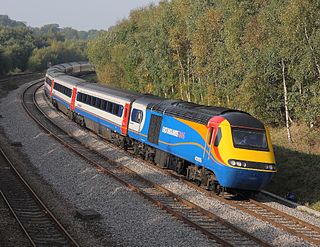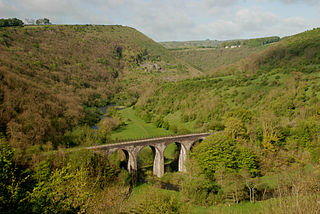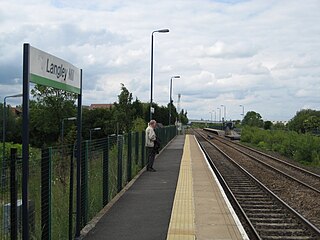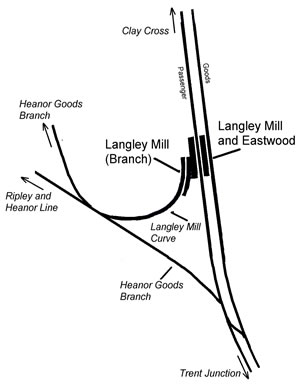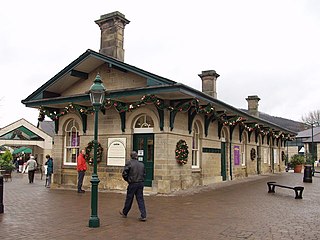History
It has a complicated history. The original station was built for the North Midland Railway in 1840, between Derby and Leeds. It was an ornate building, by Francis Thompson, [1] which would have graced a Lord of the Manor.
From Belper the line ran along the Derwent Valley, along a stretch called Broadholme, with four bridges across the river, through Longlands Tunnel, across the River Derwent and Derby road with a magnificent five-arch viaduct. It then entered Hag Wood Tunnel as turned towards the Amber Valley.
The station building was just north of this tunnel. Shortly afterwards a proposal was made for an Ambergate, Nottingham, Boston and Eastern Junction Railway which however never materialised, apart from a stretch between Colwick and Grantham.
From Ambergate, towards Chesterfield, the next difficulty for the North Midland Railway was the intersection with the Cromford Canal, where the line intersected with the Bullbridge Aqueduct, before it carried on through a station at Wingfield to Stretton.
However, in 1849, the branch from Ambergate to Rowsley was built by the proposed Manchester, Buxton, Matlock and Midland Junction Railway, with a west to north connection between the lines at the original Ambergate Junction. When a south to west connection was made, for trains from Derby to Rowsley, in 1863 the station building was rebuilt adjacent to the new Ambergate South junction. The original bridge was also widened at its northern end to accommodate the new junction.
In 1867 the Rowsley line had reached New Mills, which meant that the Midland Railway could operate from London to Manchester and Liverpool.
In 1875 Ambergate to Pye Bridge Line was opened from Crich Junction near Bullbridge which ran through Butterley to Pye Bridge, near Ironville on the Erewash Valley Line. Much of its business was coal traffic from Nottinghamshire to Manchester and Liverpool, avoiding Derby.
The triangular station
In 1876 a loop was built passing the west side of Hag Wood Tunnel, as a diversion from the original line to a third platform, which allowed for Derby to Sheffield stopping trains. The station was completely rebuilt, with the old building remaining in use a plans store. This third and final station was the famous triangular one, making it one of the four triangular stations in the UK. The other triangular railways stations are Earlestown station in Merseyside, Shipley station in West Yorkshire and Queensbury station also in West Yorkshire which closed to passengers in 1955.
On Monday 20 March 1899 a fire broke out on the down platform for the North which destroyed 30 yards of platform, together with the booking hall, stationmaster’s office and waiting rooms. [2] The fire brigade from Belper were summoned as well as the Midland Railway company brigade from Derby.
Throughout the late 19th and early 20th centuries, Ambergate was an important railway interchange with 28,207 tickets sold in 1872 rising to 90,157 by 1922.
In 1931 the line across Broadholme approaching from the south was upgraded to four tracks. Longlands Tunnel was opened up to form a wide cutting and the junction with the Manchester line was moved south of the river. A new modern steel bridge for the Manchester line was built alongside the original viaduct over the River Derwent and the A6 main road.
The line through Matlock, then the 'main line', carried London to Manchester expresses such as the Palatine and the Peaks. It also carried coal trains from Nottinghamshire, for a while with Garratt locomotives, which would be split at Rowsley for the long climb to Peak Forest.
Decline
The stopping service on the former North Midland route to Chesterfield & Sheffield (using the eastern platforms on the slow lines) was withdrawn in January 1967, when the other local stations on this section were closed. Most of the trackwork on the Derwent Valley line was lifted in 1968, soon after the closure of line from Rowsley to Buxton & Manchester whilst the line eastwards from Crich Junction to Butterley & Pye Bridge closed completely in December that year. The station buildings were removed in 1970. Although the triangular station site remained for a number of years, the eastern road bridge over the A610 was finally removed in the late 1980s. All that is left now is one platform on the surviving single track to Matlock, and the original main Derby to Sheffield line passing to the east through Hag Wood (Toadmoor) Tunnel and onwards to Clay Cross and Chesterfield. The original listing of Ambergate station for closure under the Beeching Axe led to its mention in the song "Slow Train" by Flanders and Swann.
Stationmasters
- Thomas Whitmore ca. 1853 ca. 1857
- Charles Grundy ca. 1860 [4] - 1898 [5]
- Robert Manners 1898 [6] - 1925 [7] (formerly station master at Chinley)
- Albert Ernest Weatherly 1925 [8] - 1928 (formerly station master at Runcorn)
- H.J. Bates 1928 - 1932 [9] (formerly station master at Daventry)
- W. Turner 1933 - 1952 [10] (formerly station master at Goostrey)
- Bernard Gower ca. 1955


